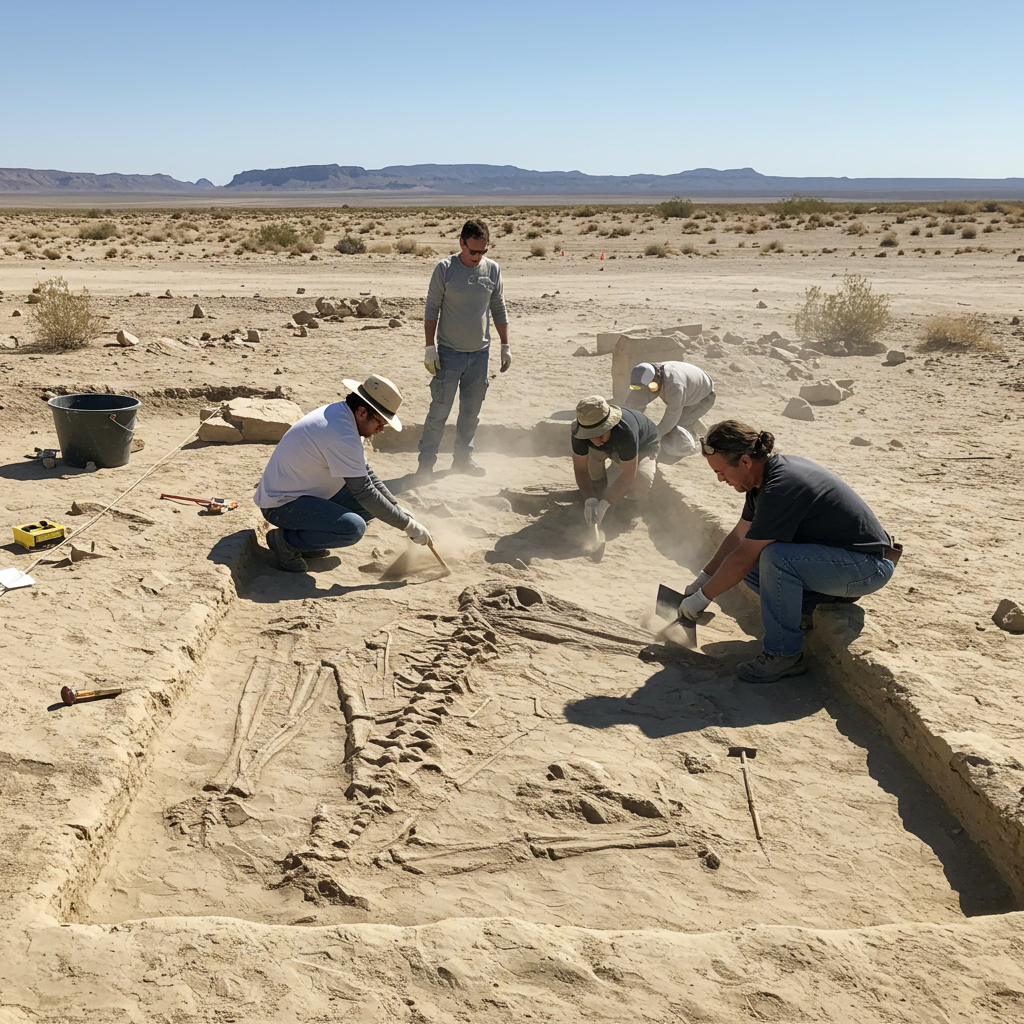A groundbreaking discovery at Arizona’s Petrified Forest National Park has unveiled the oldest known pterosaur fossil ever found in North America. Dating back an astonishing 209.2 million years to the late Triassic period, this ancient winged reptile sheds new light on the early evolution of flight. Unearthed by a Smithsonian-led research team at a remarkably rich bone bed, the fossil provides paleontologists with critical insights into a mysterious era just before a major mass extinction event. This find is not just significant for its age but also for the unique glimpse it offers into a prehistoric ecosystem teeming with fascinating creatures.
Unearthing a Triassic Treasure Trove
The journey to this significant discovery began at a remote and densely fossilized site within Petrified Forest National Park. For decades, researchers have meticulously excavated this area, uncovering thousands of specimens. The specific bone bed where the pterosaur fossil was found is packed with remains dating back approximately 209 million years. This makes it a rare window into a period from which fossils, particularly those of delicate creatures like early flying reptiles, are incredibly scarce.
The pivotal moment for the oldest North American pterosaur came when Suzanne McIntire, then a volunteer with the Smithsonian’s FossiLab, discovered a small, fragile jawbone. Recognizing its potential importance, McIntire noted that the teeth were still intact within the bone. This seemingly small detail proved crucial for identifying the animal later. The painstaking process of extracting and preparing the delicate fossils often involves bringing large blocks of sediment back to the lab for careful work, highlighting the dedication of researchers and volunteers like McIntire.
Meeting Eotephradactylus mcintireae: The Ash-Winged Dawn Goddess
Scientists have formally named the newly discovered pterosaur species Eotephradactylus mcintireae. The genus name, Eotephradactylus, is rich with meaning. “Eo” refers to Eos, the Greek goddess of dawn, symbolizing the animal’s position near the evolutionary dawn of pterosaurs. “Tephra” translates to ash, a nod to the volcanic ash layers present at the discovery site that helped preserve and date the fossil. “Dactyl” relates to the finger-like structure supporting the pterosaur’s wings. The species name, mcintireae, is a direct honor to Suzanne McIntire for her vital role in its discovery.
Contrary to the popular image of giant pterosaurs like the pterodactyl soaring through the skies much later in history, Eotephradactylus mcintireae was surprisingly small. Estimates suggest it was roughly the size of a small seagull. Lead author Ben Kligman, a paleontologist at the Smithsonian’s National Museum of Natural History, noted it would have been small enough to comfortably perch on a person’s shoulder. Analysis of its jaw revealed worn-down teeth, strongly suggesting a diet that included prey with hard, armored scales, such as the primitive fish abundant in the ancient waterways of the region. The structure of its teeth, fused into the socket, also shows similarities to a group of small Triassic reptiles called lagerpetids, which some scientists hypothesize might be closely related to pterosaurs.
Why This Ancient Fossil Matters So Much
Finding early pterosaur fossils from the Triassic period is exceptionally rare. Pterosaurs, while the first vertebrates to achieve powered flight, possessed lightweight, hollow bones and delicate structures. These features, perfect for flight, made their skeletons highly susceptible to destruction before fossilization could occur. They also often lived in environments not conducive to fossil preservation.
The discovery of Eotephradactylus mcintireae is therefore highly significant. Preserved within a river deposit mixed with volcanic ash, the fossil’s environment was unusual for early pterosaur finds, suggesting new potential search areas. The presence of volcanic ash was particularly valuable. It allowed geologists to determine the fossil’s age with remarkable precision: 209.2 million years old. This precise dating is vital for understanding how this early flying reptile fits into the broader patterns of evolutionary and environmental changes preceding the end-Triassic extinction event around 201 million years ago. The fossil record of early pterosaur evolution is patchy, with these creatures seemingly appearing with fully formed wings around 215 million years ago. Eotephradactylus helps bridge a critical gap, providing concrete evidence of what these early forms were like just before a major turning point in Earth’s history.
A Snapshot of a Prehistoric World
The bone bed at Petrified Forest National Park is more than just the site of a pterosaur discovery. It’s a vibrant snapshot of an ancient ecosystem. During the late Triassic, this part of Arizona was located near the equator on the supercontinent Pangaea. It was a semi-arid floodplain crisscrossed by rivers and streams. A rapid burial event, possibly a flood carrying sediment and volcanic ash, likely preserved the diverse community of animals found there.
Alongside the oldest North American pterosaur, researchers have uncovered fossils of giant amphibians, some reaching up to six feet long. Armored crocodile relatives, known as aetosaurs, also roamed this landscape. The site reveals a fascinating coexistence of these older, more archaic groups with evolutionary “upstarts” that would later dominate the Jurassic and Cretaceous periods. These include early turtles, frogs, and lizard relatives.
Notably, the site also yielded one of the world’s oldest known turtle fossils. This turtle, described as having spike-like armor and a shell small enough to fit in a shoebox, suggests surprisingly rapid dispersal of early turtles across the vast landmass of Pangaea. Finding such diverse groups living together simultaneously, particularly before the end-Triassic extinction event thinned the ranks of the older lineages, provides invaluable evidence of a unique transitional period in vertebrate evolution. Fossil beds like this are crucial for establishing the actual cohabitation and ecological relationships of these ancient animal communities.
Challenges and Future Horizons
The challenges of finding and studying early pterosaurs remain significant. Their delicate skeletons mean many fossils were simply lost to time. The unusual preservation environment of Eotephradactylus in a river deposit suggests that paleontologists may need to broaden their search image. Looking for similar ancient riverbeds in Triassic rock formations around the world could yield more discoveries.
This find at Petrified Forest National Park is a powerful reminder of the vast amount we still have to learn about prehistoric life. It provides concrete anatomical details from one of the few well-preserved early pterosaur fossils found globally. Specifically, its three-dimensional preservation and the details of its jaw and teeth offer unique insights. Researchers hope that this discovery will inspire new expeditions and techniques to uncover more clues about the mysterious origins and early diversification of the first vertebrates to take to the skies.
Frequently Asked Questions
What is special about the Eotephradactylus mcintireae discovery?
Eotephradactylus mcintireae is currently the oldest known pterosaur fossil found in North America. It dates back precisely 209.2 million years, offering a rare glimpse into a crucial period of pterosaur evolution just before the end-Triassic extinction event. Its discovery in a river deposit with volcanic ash was also unusual for early pterosaurs, and the fossil is one of few early ones preserved in three dimensions, providing valuable anatomical details.
What was the ancient environment like where the pterosaur fossil was found?
The fossil was discovered in Petrified Forest National Park, Arizona, which during the late Triassic period (209 million years ago) was an arid floodplain near the equator on the supercontinent Pangaea. This landscape featured rivers and streams. The fossils were preserved in a bone bed within this ancient river system, likely due to rapid burial by sediment and volcanic ash from nearby eruptions.
Why are early pterosaur fossils so hard to find?
Early pterosaurs had lightweight, hollow bones and delicate structures necessary for flight. These features made their skeletons fragile and easily destroyed before they could fossilize. Furthermore, the environments where they lived were not always conducive to fossil preservation. Finding well-preserved Triassic pterosaur fossils like Eotephradactylus mcintireae is rare, making this Arizona discovery particularly significant.
Conclusion
The discovery of Eotephradactylus mcintireae, the oldest North American pterosaur, in Arizona is a monumental find in paleontology. This tiny “ash-winged dawn goddess” provides invaluable data on the early evolution of flight and the anatomy of Triassic pterosaurs, helping to fill crucial gaps in the fossil record. Moreover, the bone bed where it was found offers a unique snapshot of an ancient ecosystem where distinct groups of animals coexisted before a major global extinction. This discovery underscores the importance of continued exploration in places like Petrified Forest National Park and inspires hope that other ancient river deposits around the world might hold more secrets about the fascinating history of life on Earth.
References
- www.cbsnews.com
- www.livescience.com
- www.newsweek.com
- www.bbc.com
- <a href="https://www.nationalgeographic.com/science/article/pterosaur-ash-winged-dawn-goddess-discovery?userab=ngpwcopy-287%2Avarianta-1126%2Cnatgeoglobalnavtests-359%2Avariantbnavsubscribe-1476″>www.nationalgeographic.com




